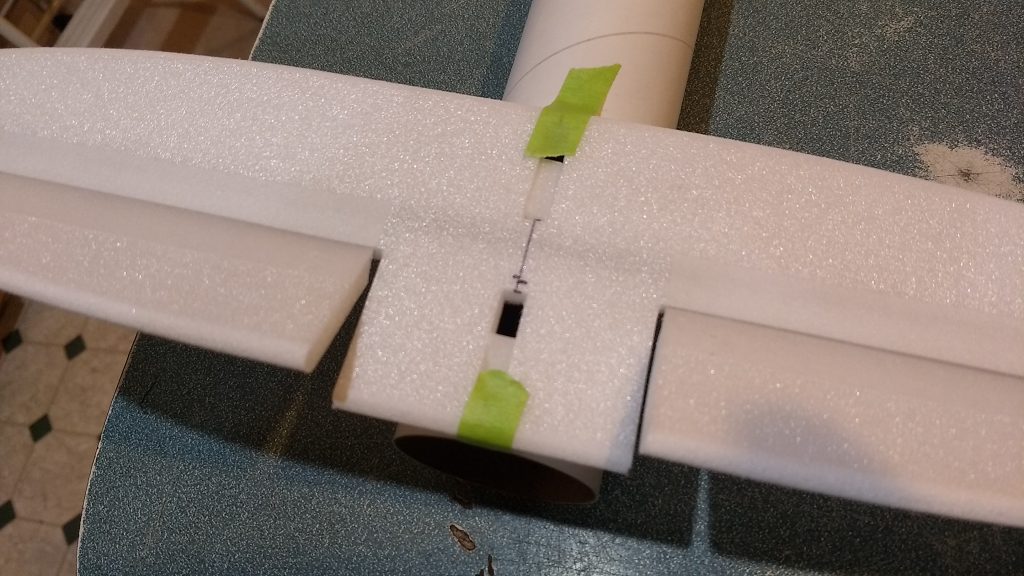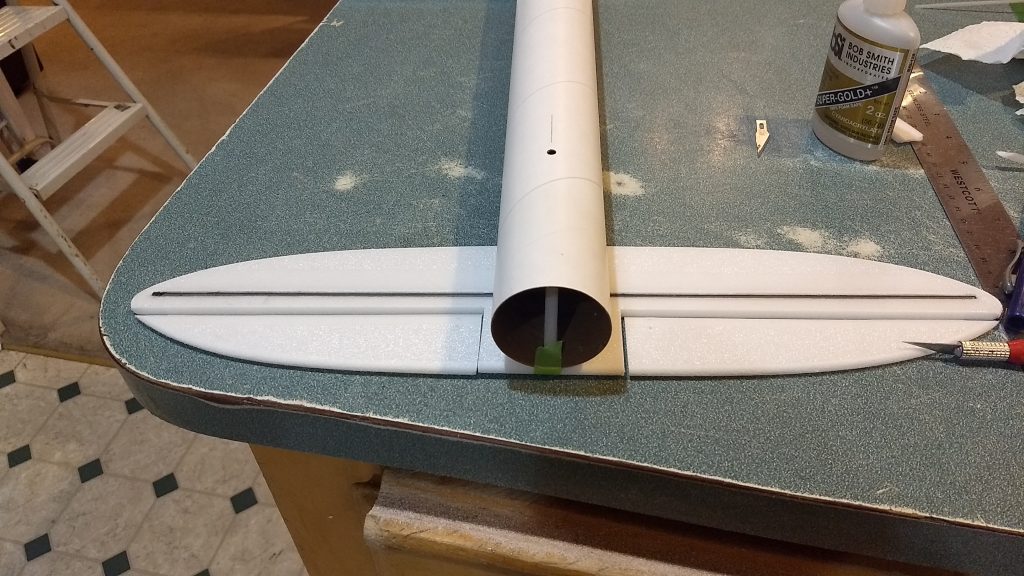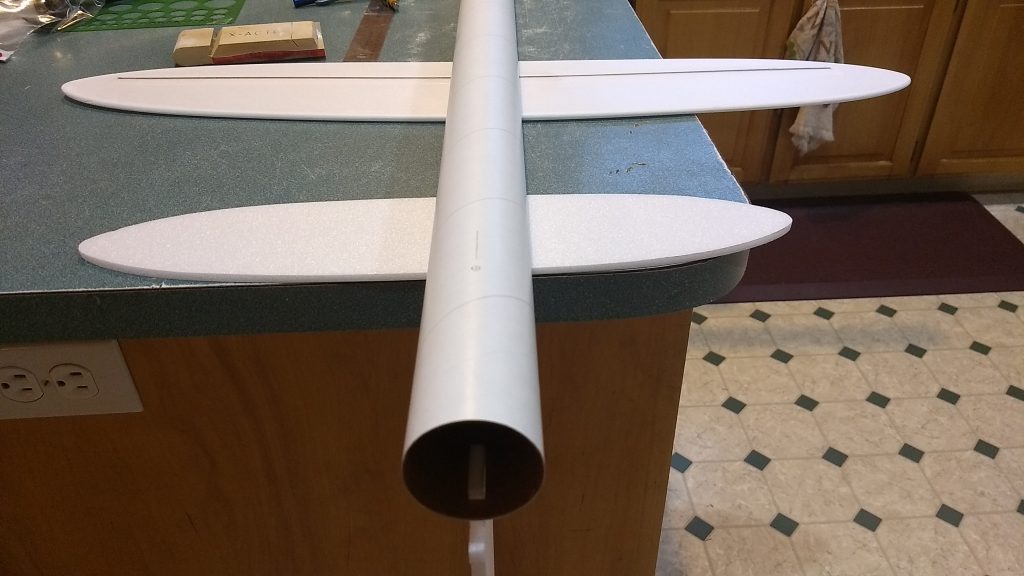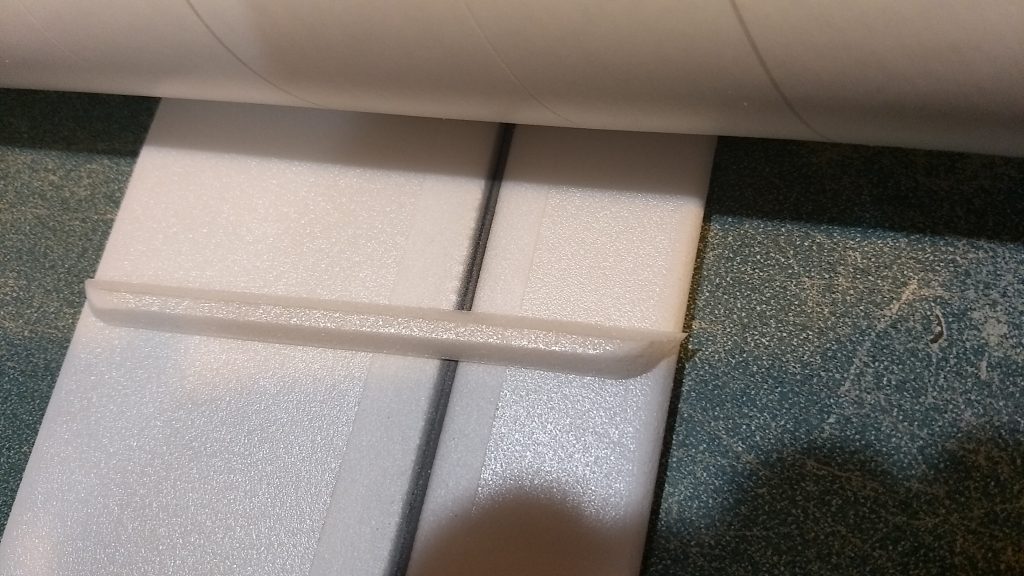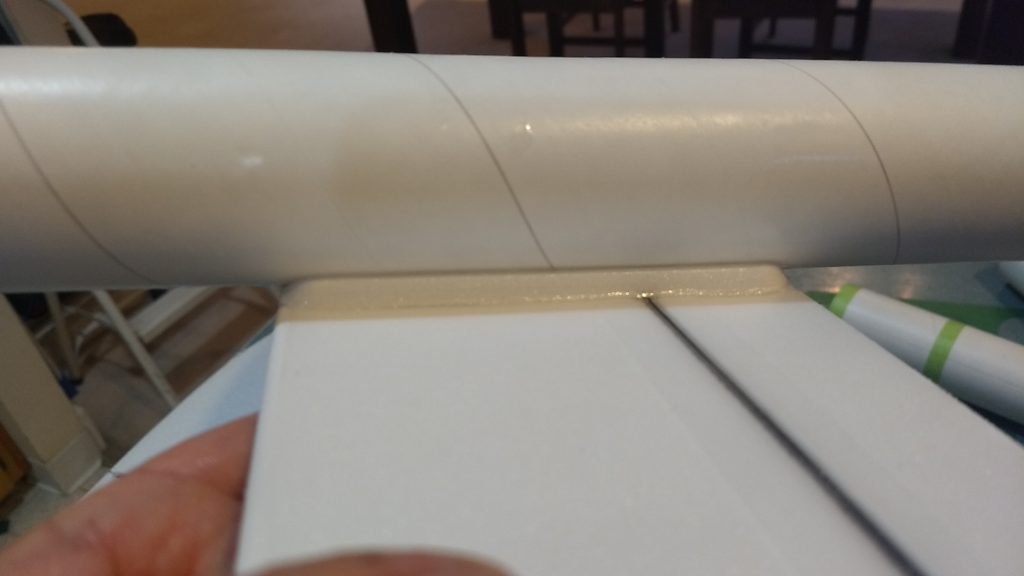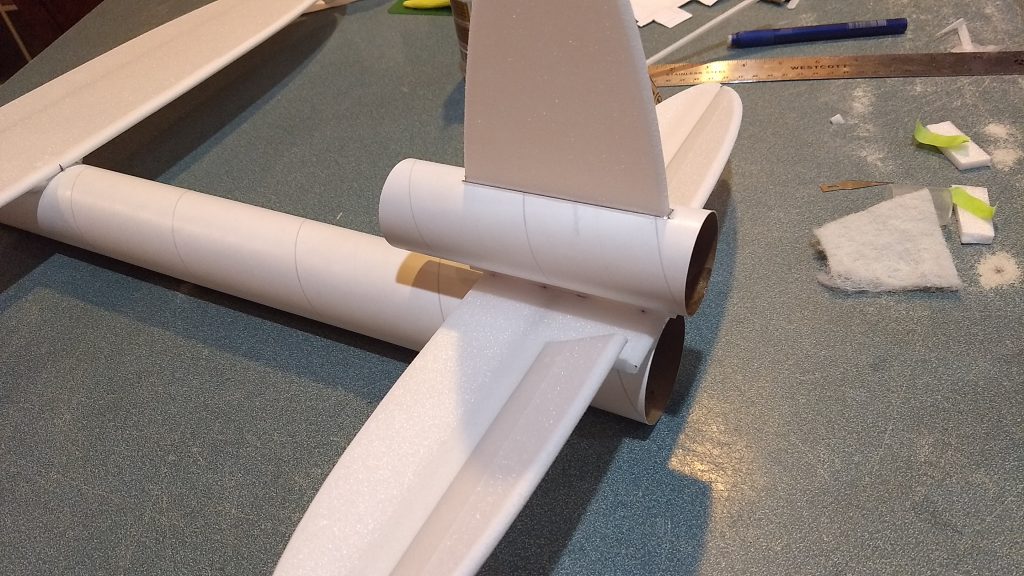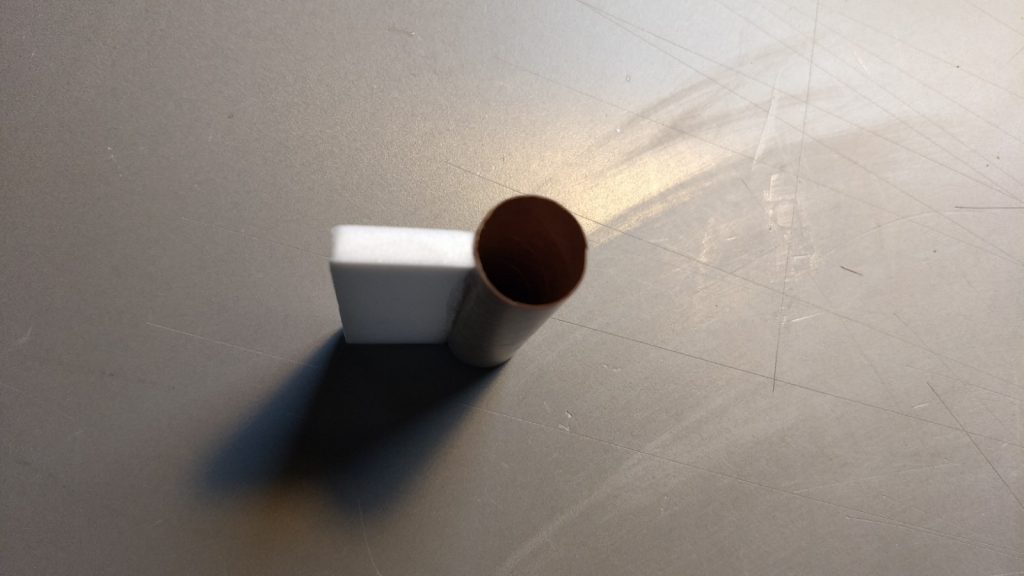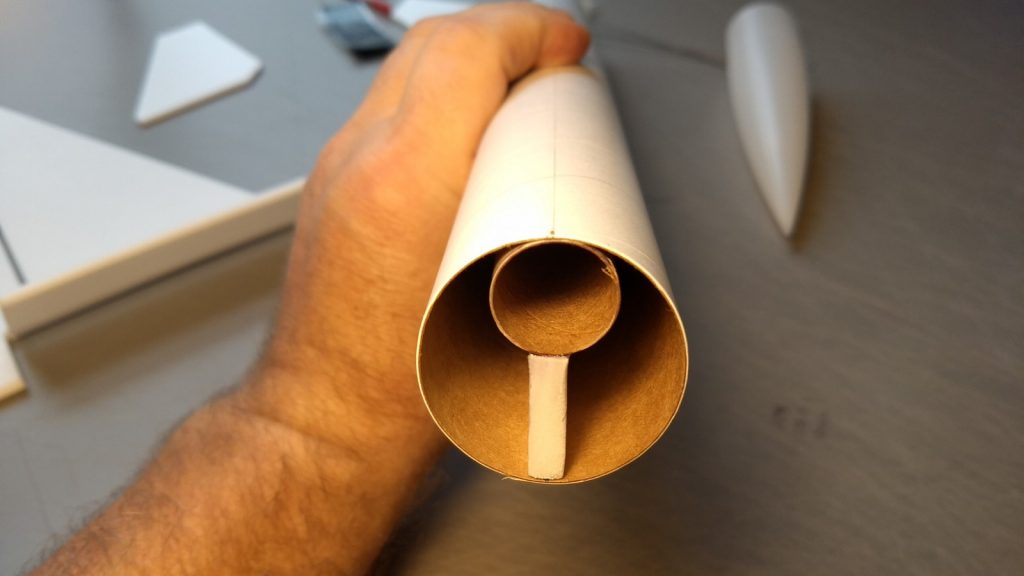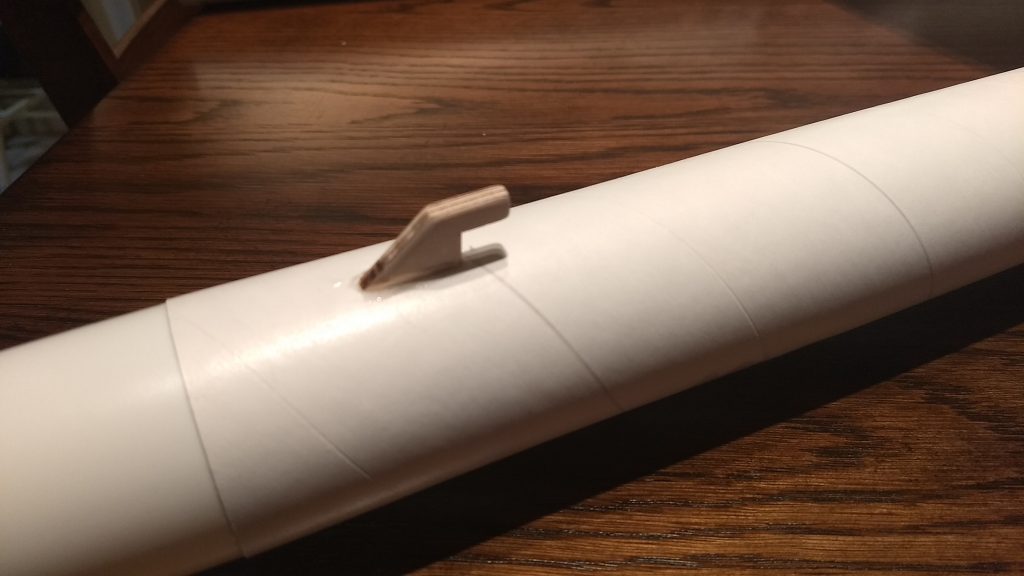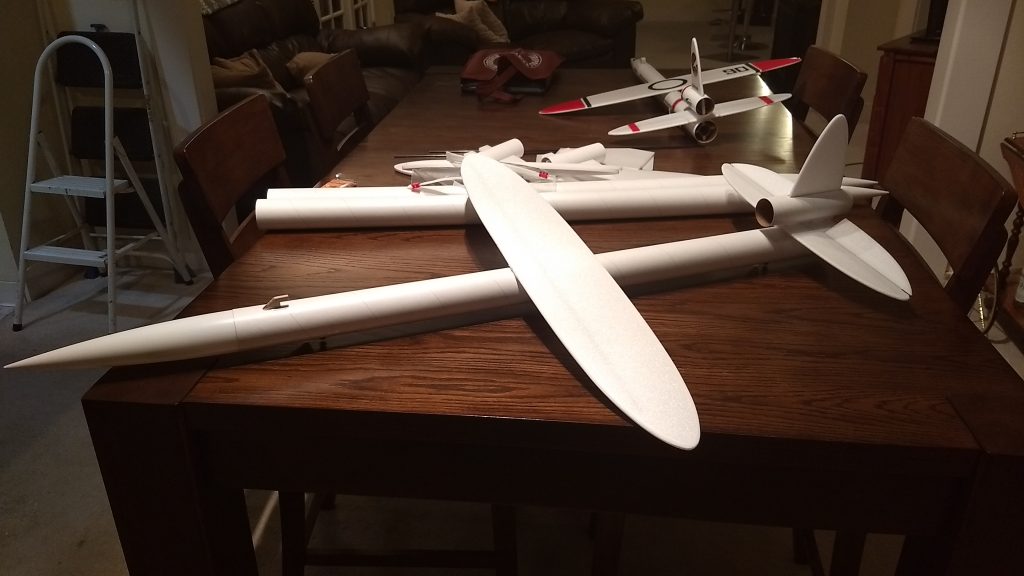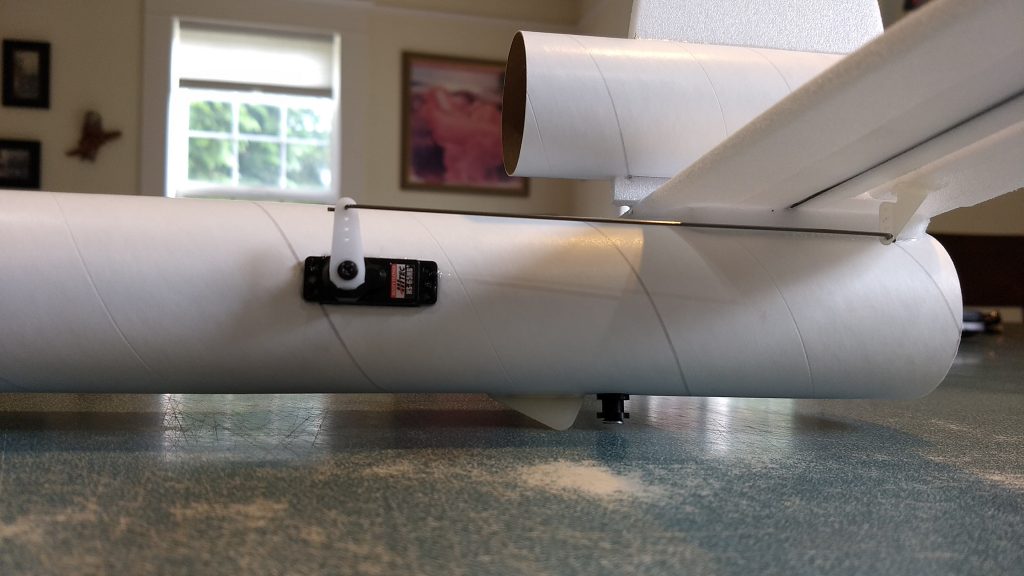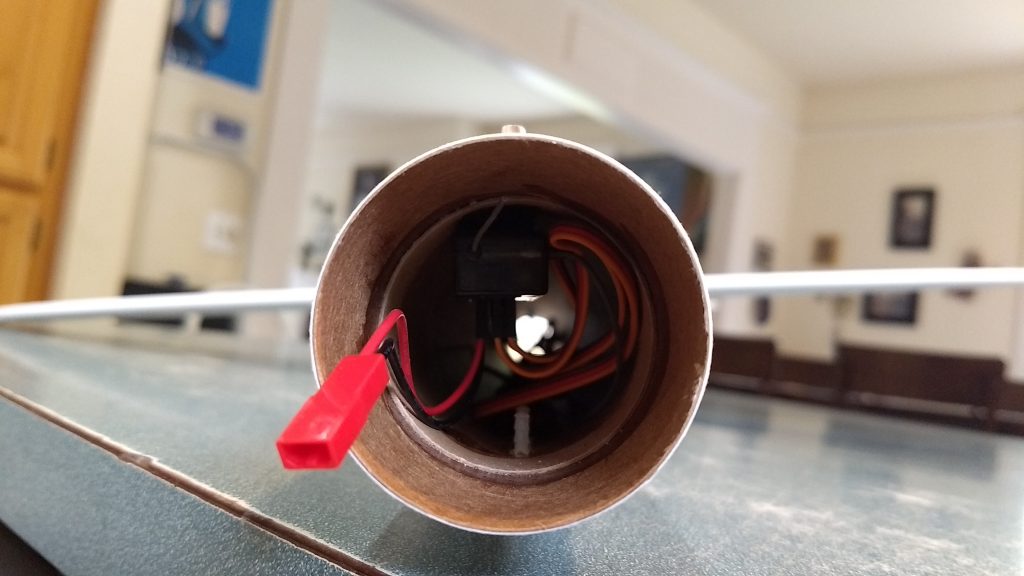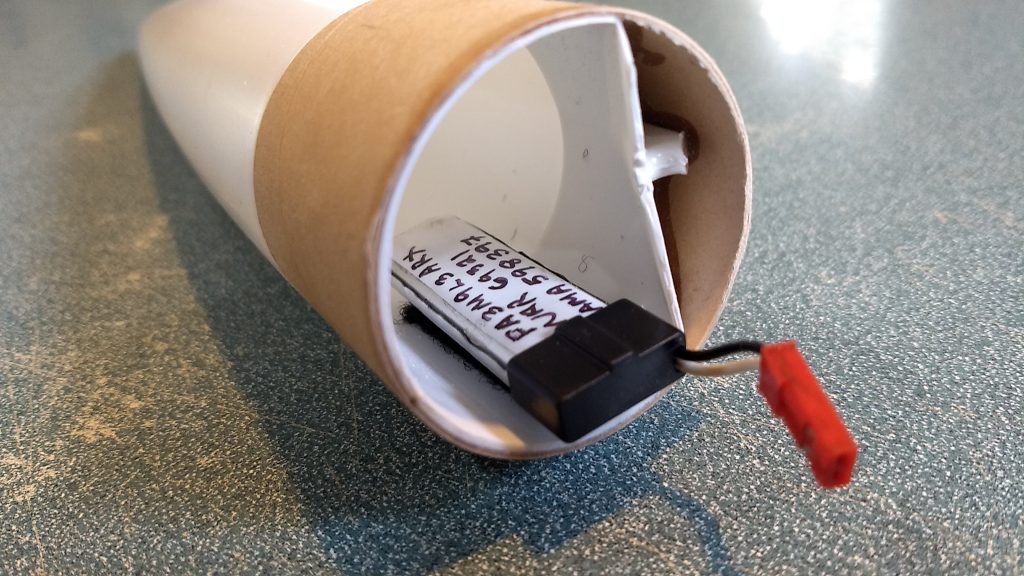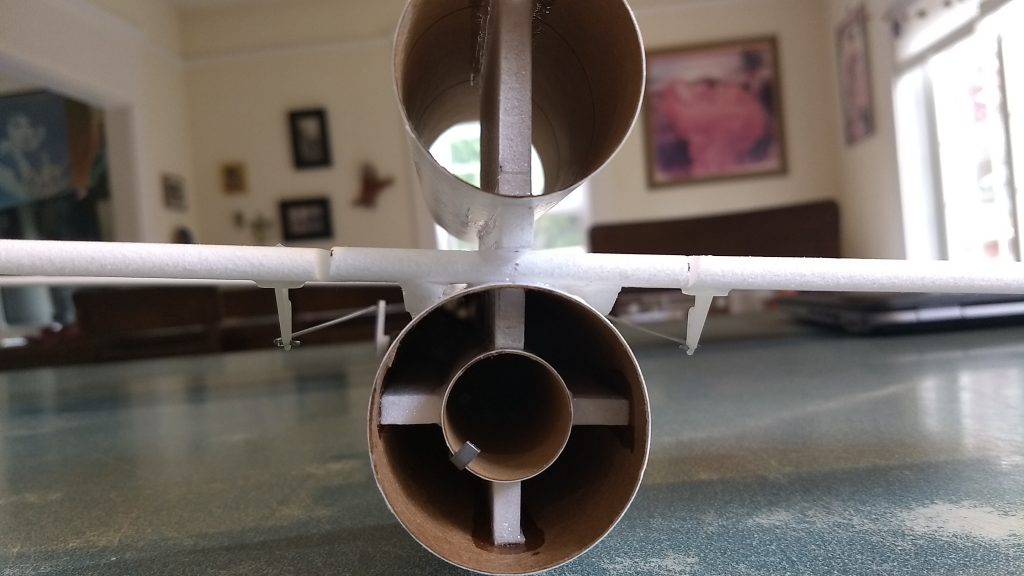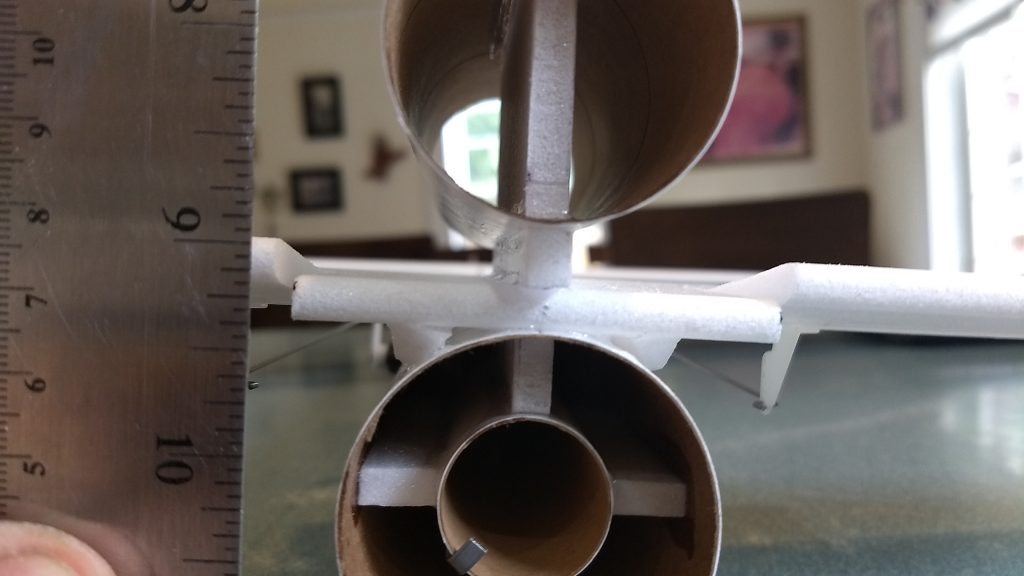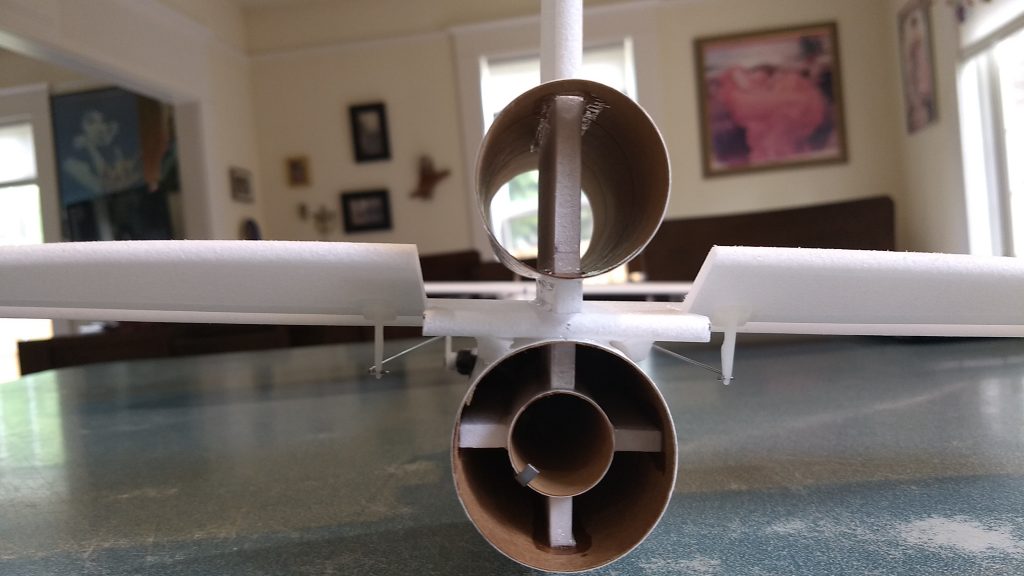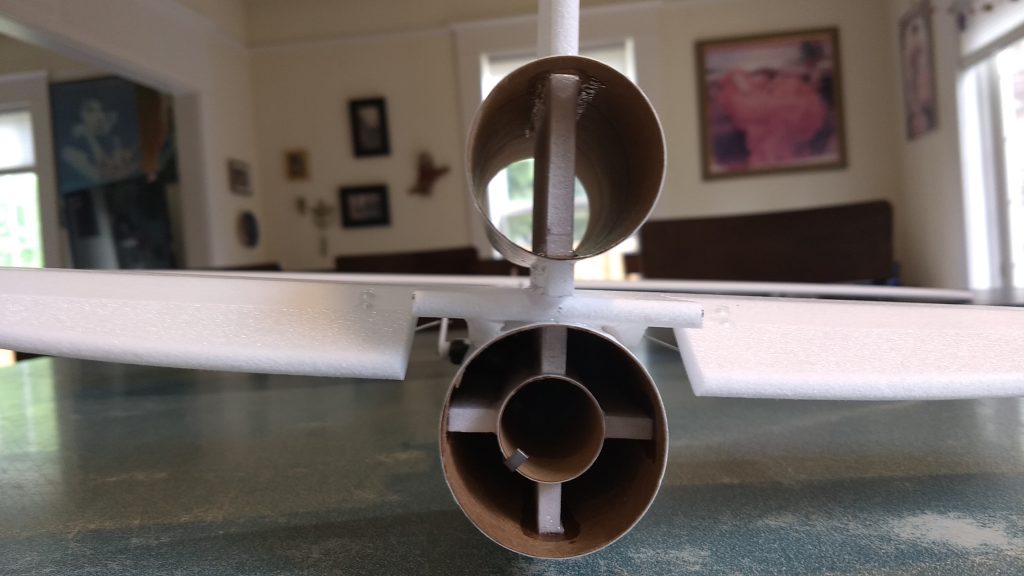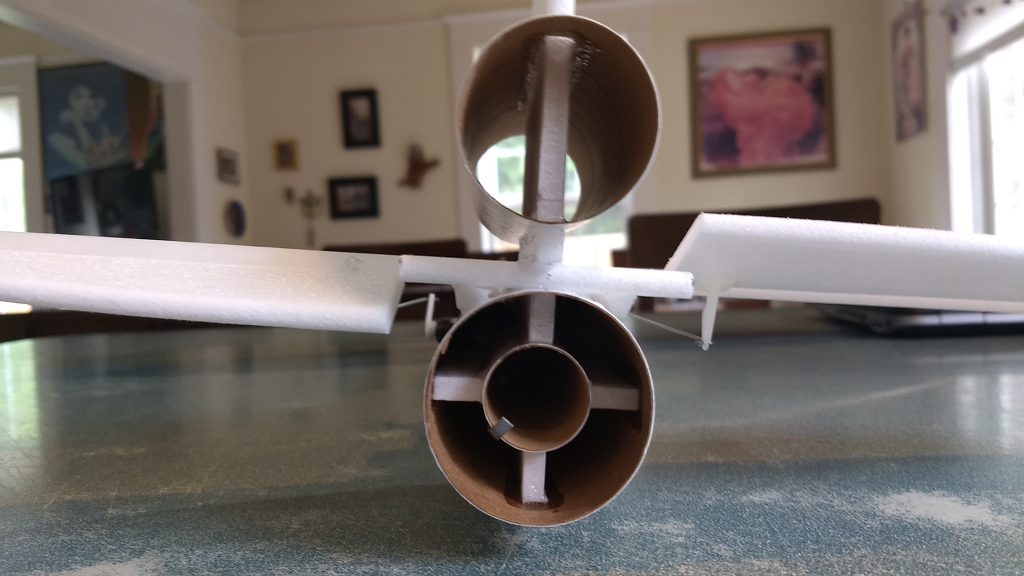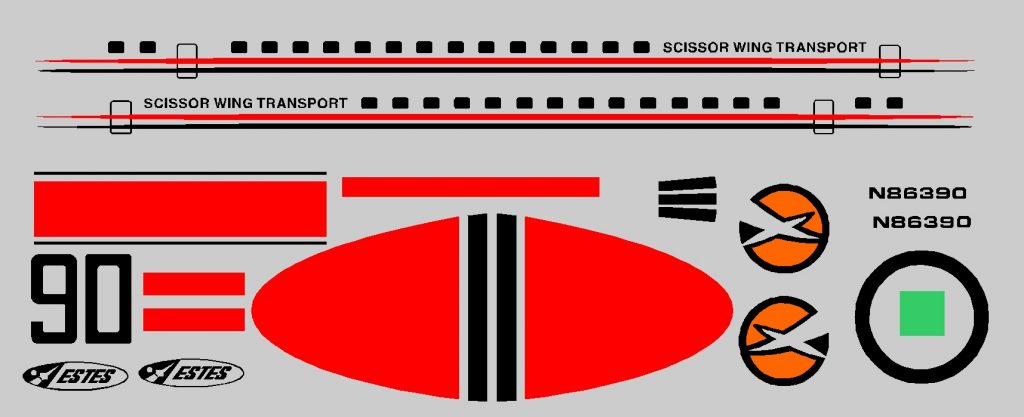
The Scissor Wing Transport Mk II RC Rocket glider kit is a 1.7x upscale modeled after Estes Scissor wing transport rocket glider. It comes with a plastic nose cone, 1.65″ white tubing for the body and 6mm depron wing and tail surfaces. You will need two 9-10 gram type servos, two 18-24″ servo extensions, a receiver, and a small 500mah single cell lipo battery with jst connector. You will need a transmitter with delta or elevon mixing and a lightweight sub 10 gram receiver. Please refer to the general instructions link above, then read the instructions completely before starting assembly. The assembly photos are for general reference but may not include every step in the instructions. Everything is white so no paint is required. 42″ length, 28″ wingspan, 9.5 oz rtf, and 8.5 oz glide weight. Decals are available from stickershock23.com Just tell Mark you need the Scissor Wing Transport decals that Frank used for his R/C version.
**CG location for fixed wing rocket flight: 1.5″ back from the LE of the wing RTF with motor installed. This model is designed to fly on the 24mm Aerotech E-6 rocket motor only with a very mild long boost and low speed.
This kit is not intended nor designed to support swing wing function as the wing is moved back 1″ from the center to reduce the nose weight required for flight.
Welcome to the world of rocket boosted radio control gliders. This is not a model for a novice RC pilot, but anyone who is comfortable with RC flying of a medium speed model should be fine. Read through the instructions, look at the photos and be sure you understand the step before commiting to cutting or glue.
Identify all pieces, the kit should contain:
1 wing
1 horizontal stab with spar installed and surfaces hinged.
1 vertical stab
1 thrust ring
1 vertical stab tube 5.25″ long by 40mm
1 Nose Cone
2 pushrods with control horns.
2 long and 2 short foam reinforcing strips for the wing/tail body tube joint.
1 body tube
Motor mount
1 foam centering strip for the motor mount.
1 foam simulated front wing hook
Velcro(for battery and rx/bec attachment)
2 Rail buttons with t nuts/screws
Battery adapter for 1s Lipo to rx
Lead weight
Spare foam
Notes before starting:
Reference to CA+ means foam safe CA+, normal CA+ will melt the foam! Normally you need to use accelerator to get the CA to set on the foam since there is nothing for it to soak into and activate.
You may use 220-320 grit sandpaper and a sanding block to slightly round or taper the edges of the foam if you prefer that look. It will not markedly impact the flight performance either way. Be very careful and use a light touch, it is very easy to catch the foam on the edge of the paper and tear the foam. Do any sanding before assembly.
Epoxy is not needed in this model. Weight is critical and the model is designed for the thrust and flight loads. Weight in the rear end is bad and will require additional weight in the front of the model.
Assembly:
- Install the front and rear rail buttons into the pre punched holes. The rail buttons will be om the bottom of the model.
- Lightly sand the top wing line on the body tube to help adhesion of the glue.
- Glue the horizontal stab to the body tube, you can insert the two foam strips flush with the top of the stab to locate it in place, then flip it upside down and use a triangle to make sure the center of the stab and the line on the bottom of the tube are vertical.
- Add the small reinforcing strips on either side like you did on the wing, these go into the joint where the horizontal stab meets the tube.
- Apply foam safe CA+ onto the wing line and also down the center line of the underside of the wing. The underside has the spar visible.
- Attach the wing onto the body tube keeping it straight and keeping the rear of the wing aligned the marked wing line on the body tube. The front and rear wing locations are marked. The rear of the wing should be 14.25″ forward from the rear of the body tube, the front should be ~18.75″ forward from the rear, kits may be mismarked at 19.75″ so check and use the rear wing mark for correct placement. You can use a little bit of tape to hold the wing in place in the front and back so it doesn’t slide forward/backward. Then quickly flip the wing/body over onto a flat surface. Measured from front bottom rail button to each wingtip to make sure the wing is straight.
- Glue the two long reinforcing strips on either side of the wing, against the body tube and the wing. Don’t push this in too hard as it can rotate the body tube relative to the wing. All this piece does is to act as a filler to allow you to put additional CA fillets against the wing and body tube to help it attach firmly. The angled cut goes into the wing joint. Apply a fillet of CA+ onto the strip and wing/body tube joints.
- Slide the vertical stab through the slots in the short body tube till it hits the notches on the stab, there should be about 5/8″ of foam sticking out the bottom. Apply glue to both the top and bottom tube/stab joint and make sure it is set.
- Carefully insert the vertical stab into the notch in the horizontal stab and make sure it is seated. You may need to cut a small notch to clear the horizontal stab spar so it will seat fully. Make sure it is perpendicular to the stab and then glue in place.
- Glue the foam centering tab onto the motor mount on any of the pre-marked lines.
- If you intend on using single use motors you can glue the thrust ring to the front of the motor tube, if you are using reload casings the casing rear ring will provide the stop and allow the motor to go forward fully and reduce nose weight, in this case leave off the thrust ring.
- Test fit the motor mount into the body tube. Lightly sand the foam strip till it will insert snugly. Use the line on the motor tube, the inside top line in the body tube, the rear center line of the stab and the bottom foam tab/body tube line to make sure it is aligned and flush with the end of the body tube.
- Glue the motor mount into the rear of the model by running glue on both sides of the foam tab and the joint between the motor tube and body tube.
- Glue a pushrod/control horn into the bottom each elevator half in the pre-made holes. I have the pushrod on the outside away from the body tube.
- Apply some foam safe CA+ to the top of the prongs to lock them in place.
- Glue your dummy front retaining block the the top of the model about 1″ back from the front of the body tube.
- The basic construction is now complete.
Radio Installation
Note: Your radio needs to be configured for Delta mixing, this means that the servo arms will move the same direction during elevator stick movement and opposite for aileron stick movement. Connect your servos to the receiver one in the aileron connection and one on the elevator connection and apply power. Use a servo arm at least 9/16” long Zero out any trim settings on the transmitter.
- Mark where the servos will be when the control surfaces are level(I tape the elevators in place for this step.) Cut pockets to fit the servos so that they fit snug and the elevators will be level.
- Attach an 18″- 24″ servo extension to each servo.You just need to be able to route the wire to the front of the tube to attach it to the receiver. Route them into the servo pocket in the body tube toward the front and install the servos. Install the servos so that the electrical wire points forward. and so that the servo horn is pointing up.
- Attach the servos into the receiver at the front of the model and power up the radio and receiver.
- Make sure the control surfaces are level If necessary trim the pocket front or back to slide the servo slightly for best alignment. and glue the servo in place. Repeat for the other side. Use the transmitter trims to make any small adjustments needed.
- Moving the transmitter stick back(up elevator) should move both stabilizers trailing edges up. Moving the transmitter stick to the right should move the right elevator up and the left down. If you can’t get the servo reversing to give you the right polarity try swapping aileron/elevator inputs to the receiver If that is correct, continue.
- Now measure the control surface movement. Full elevator movement should be 5/8″ in each direction, aileron movement should be 1/2″ in either direction.
- If you have a flap/elevator mix you can program up elevator to a switch setting. The model needs approximately 3/16-1/4″ of up elevator trim during glide. If you can’t set the up elevator trim to a switch on your radio you’ll have to manually put in boost and glide trim which is hard to do while flying the model.
- Use the included Velcro to attach the battery in the nose cone.
- Attach the receiver inside the front of the body tube behind the nose cone shoulder but not so far the battery wire can’t reach the battery.
- Insert your heaviest loaded rocket motor into the motor mount and install the battery.
- Support the model at the spar at the CG location indcated near the top of this page in red. Use the included lead weight to balance it slightly nose down. Do not try to fly the model with it balancing it behind this point. The adage is, a nose heavy model flies poorly, a tail heavy model flies once
- If you use stickershock cut vinyl markings, It helps once applied to use a hair dryer on hot to soften the material and then push it down onto the model with a towel. It helps it conform and stick much better. The decals are slightly oversized for length of the red/black body band so you can cut it to fit. The wingtips are also cut oversized so you can trace and cut them to fit your wing perfectly after sanding.
- Flying: See the General Instruction/Information link at the top for flying instructions. Be ready on the first few flights to keep the model straight till you have the trims set perfectly for boost and glide.
- install front and rear rail button
- glue the horizontal stab in place using tape
- lay the model upside down to make sure the stab is flat and use a triangle to make sure the body tube bottom is vertical to the stab.
- Glue the wing in place making sure is is flat with the horizontal stab and the wing tips are equal distance to the front of the body tube.
- Install the short foam gussets on each side of the stabilizer/body joint and long gussets on each side of the wing/body tube joint.
- Gussets installed
- Slide the stab into the short tube and glue in place. Test fit the stab into the slot in the horizontal stab and glue in place with the longer portion of the tube pointing forward.
- Glue the centering strip to the motor tube.
- Motor mount inserted flush with rear of the model, tube aligned with wing line at the top and rail buttons on the bottom.
- glue in control horn into the bottom of each control surface
- add glue on the prongs on top of each control horn/suface
- Glue the wing hold down approx 1″ from the front of the body tube.
- Completed airframe
- cut pockets for your servos making sure the control surface will be level when the servo is in place.
- Install the servos and make sure the control surfaces are level, note servo arms point up. Connect the wires to the receiver and power up the radio, ensure movement and then glue servos in place.
- Run servo wires to receiver and mount receiver with velcro inside the body tube.
- Mount the battery with velcro inside the nose cone as far as the battery wire will reach.
- Neutral controls
- Up trim for glide
- Up elevator
- down elevator
- right aileron
- left aileron
- Completed model shown with stickershock markings.
- Example of stickershock decals

